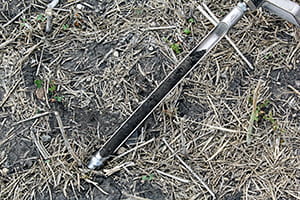When harvest wraps up, there are some things to consider right after. Fall soil testing, for example, is always a good practice to make the most efficient use of the fertility dollar. This year’s unusually dry conditions make soil testing even more important.
In most years, crops use up a lot of the nutrients that were in the soil. This year, due to the dry conditions, some nutrients may not have been consumed or were lost to leaching and immobilization.

Some nutrients such as phosphorus and potassium, may be in sufficient amounts and you can save costs by reducing application volumes next year. This will depend on previous fertilizer practices and the amount of crop harvested this year. In the case of potassium in light textured soils, it will also depend on the amount of precipitation received between now and spring that can result in leaching.
Nitrogen and sulphur also have the potential to be present in higher-than usual-residual amounts. However, prediction of these levels is much more complex. Both are highly mobile in the soil and are subject to leaching. How far they move depends on the level of moisture recharge and when it happens. In the case of nitrogen, other losses such as immobilization, volatilization and denitrification may also occur. These processes may have been reduced due to dry conditions but by how much is difficult to say. Therefore, it is very difficult to determine exactly what has been left behind, how available it is and where it is. The only way to know for sure is to soil test.
When soil testing, the most important thing to remember is that a test is only as good as the soil sample taken. It is recommended to take a minimum of 15 to 20 samples per field. Taking more samples improves accuracy, especially in larger fields. Avoid irregular areas of the field. If you hire someone to collect your soil samples, it is a good idea to go with them to point out unrepresentative areas in the field or give accurate directions to avoid these areas.
Fall soil sampling should be done after the soil temperature has dropped below 10 C. This minimizes the risk of nitrogen mineralization before freeze-up. Mineralization is the process where nitrogen in its organic form is converted to a plant available form by soil microbial activity. Lower soil temperatures ensure that this activity has ceased and that the nitrogen levels measured are less likely to change before spring. Soil phosphorus and potassium are generally less affected by sampling date.
Soil testing on a regular basis has certain advantages. It will help to establish upcoming crop nutrient need, monitor changes in nutrient levels over time and guide in nutrient management planning.
Nutrient management planning should take into account not only the requirements for the next crop, but also maintenance of the correct nutrient balance well into the future. Phosphorus is a good example of the importance of nutrient balance. Increased yields without increased phosphorus application rates has resulted in some fields approaching deficiency levels. Since fertilizer use efficiency also decreases as availability decreases, the problem is compounded. It can take multiple seasons to restore this balance, so soil testing to avoid phosphorus deficiencies is important.
Fall soil testing can also be used to inform decisions about when to purchase crop nutrients, as it is difficult to predict where fertilizer prices are going to go.
For more information on fall soil testing, please contact the Agriculture Knowledge Centre at 1-866-457-2377 or your local crops extension specialist.
